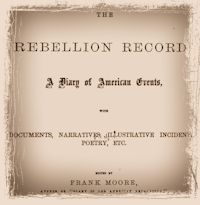June 9.—The tow-boat Boston was captured by a party of rebels under the command of Captain James Duke, while towing the ship Jenny Lind up the Mississippi River. The capture took place at a point about three miles from the Pass à 1′ Outre lighthouse.—(Doc. 63.)
—A Magazine at Fort Lyon, near Alexandria, Ta., exploded, killing twenty and wounding fourteen men belonging to the Third New-York artillery.—The Union cavalry, under General Mitchell, at Triune, Tenn., were attacked this morning by a large body of rebels under General Forrest After a severe fight, the rebels were routed and pursued over five miles, losing over one hundred in killed, wounded, and prisoners.—A petition to Earl Russell, concerning the departure from English ports of vessels intending to commit depredations upon the commerce of the United States, prepared and signed by a number of shipping merchants of Liverpool, was made public.—(Doc. 59.)
—General Foster, in command at Newbern, N. C., issued the following order:
“The Commanding General orders that all white male citizens between the ages of eighteen and thirty-five, within the lines of this Department, shall be at once enrolled, and the rolls forwarded to these headquarters. Commanders of districts will appoint enrolling officers, and take such steps as may be necessary to fully and promptly carry out this order.”
—A fight took place near Monticello, Ky., between the National cavalry under Colonels Carter and Kautz, and the rebels under Pegram, resulting in the rout of the latter, and the occupation of Monticello by the National troops.—(Doc. 60.)
—The Savannah Republican, of this date, says: “The movements of Rosecrans still continue clouded in mystery, and it is not known whether he has sent off any of his force or not. It is very difficult to obtain any information of his movements, as he has established a chain of patrols, and it is well-nigh impossible for scouts and spies to penetrate his lines. Rosecrans appears better informed of our movements. Late Yankee papers publish a list of forces which Bragg has sent to Mississippi.”—The brig Mary Alvina was captured and burned by the confederate privateer Coquette.—The Military Departments of the Monongahela and the Susquehanna were created; Major-General Wm. T. H. Brooks being assigned to the former, and Major-General Darius N. Couch to the latter.—Brigadier-general Pleasanton, in command of a cavalry force numbering about six thousand, supported by the column of infantry under the command of Generals Russell and Ames, had a severe engagement near Brandy Station, Va., with the enemy’s cavalry, estimated at twelve thousand men, in which he so seriously crippled the enemy that they were unable to follow him, when, at the close of the day, he returned to the north side of the Rappahannock. General Pleasanton’s men behaved in the most gallant, manner, handsomely driving back superior forces of the enemy. Over two hundred prisoners and one battle-flag were captured.—(Docs. 10 and 62.)
—The Military Districts “of the Frontier,” and “of the Border,” were created by order of Major-General Schofield; the former under the command of General J. G. Blunt, headquarters at Fort Scott, Indian Territory; and the latter under Brigadier-General Thomas Ewing, Jr., headquarters at Kansas City.—Colonel Lawrence Williams Orton, formerly Lawrence Williams, of the Second United States cavalry, one time on General Scott’s staff, and late General Bragg’s Chief of Artillery, and Lieutenant Dunlop, of the rebel army, were arrested and hung as spies at Franklin, Tenn.—(Doc. 61.)



